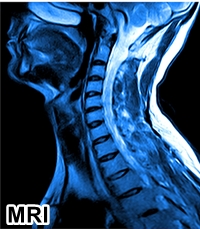MRI 2nd Opinion
What is MRI?
Magnetic resonance imaging (MRI) uses radiofrequency waves and a strong magnetic field rather than x-rays to provide remarkably clear and detailed pictures of internal organs and tissues. The technique has proven very valuable for the diagnosis of a broad range of pathologic conditions in all parts of the body including joint and musculoskeletal disorders, heart and vascular disease, stroke and cancer.

What are some common uses of the MRI procedure?
Because MRI can give such clear pictures of soft-tissue structures near and around bones, it is the most sensitive exam for spinal and joint problems. MRI is widely used to diagnose sports-related injuries, especially those affecting the knee, shoulder, hip, elbow and wrist. The images allow the physician to see even very small tears and injuries to ligaments and muscles.
In addition, MRI of the heart, aorta, coronary arteries and blood vessels is a fast, noninvasive tool for diagnosing coronary artery disease and heart problems. Physicians can examine the size and thickness of the chambers of the heart and determine the extent of damage caused by a heart attack or progressive heart disease.
Organs of the chest and abdomen-including the lungs, liver, kidney, spleen, pancreas and abdominal vessels-can also be examined in high detail with MRI, enabling the diagnosis and evaluation of tumors and functional disorders. Because no radiation exposure is involved, MRI is often the preferred diagnostic tool for examination of the male and female reproductive systems, pelvis and hips and the bladder.
Benefits
- Images of the soft-tissue structures of the body-such as the heart, lungs, liver and other organs-are clearer and more detailed than with other imaging methods.
- MRI can help physicians evaluate the function as well as the structure of many organs.
- The detail makes MRI an invaluable tool for early diagnosis and evaluation.
- MRI contrast material is less likely to produce an allergic reaction than the iodine-based materials used for conventional x-rays and CT scanning.
- MRI enables the detection of abnormalities that might be obscured by bone with other imaging methods.
- Exposure to radiation is avoided.
MRI Second Opinion
Getting an MRI Second Opinion means having another radiologist, or a team of radiologists, review all of your medical reports and test results. A second opinion may confirm the original diagnoses by your current physician/radiologist or reveal new findings that might have been missed in the earlier report(s).
An MRI Second Opinion offers additional insights and detailed information about your condition. This information might be helpful for the physician to arrive at an accurate assessment about your condition and for recommending an appropriate treatment plan for you.
Getting an MRI second opinion is not a negative hit on your current doctor/radiologist. It is merely a way of getting additional information and minimizing risk.
MRI Second opinion comes in handy in the following scenarios:
1.) If the patient fears a misdiagnosis
2.) The diagnosis is unclear
3.) The patient has questions for which he seeks answers
4.) The treatment offered is causing undesirable side effects.
